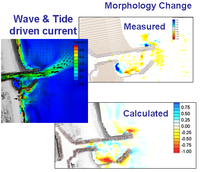CMS: Difference between revisions
| Line 1: | Line 1: | ||
=Coastal Modeling System= | =Coastal Modeling System= | ||
[[File:RudeeInlet.PNG|left| | [[File:RudeeInlet.PNG|left|200px]] | ||
The Coastal Modeling System is an suite of numerical models for simulatings flow, waves, salinity and sediment transport in coastal areas. The system is designed for practical applications in navigation channel performance and sediment management for coastal inlets and adjacent beaches in order to improve the usage of USACE Operation and Maintenance Funds. The CMS is intended as a research and engineering tool that can be used on desk-top computers. The CMS takes advantage of the Surface-water Modeling System (SMS) interface for grid generation and model setup, as well as plotting and post-processing. | The Coastal Modeling System is an suite of numerical models for simulatings flow, waves, salinity and sediment transport in coastal areas. The system is designed for practical applications in navigation channel performance and sediment management for coastal inlets and adjacent beaches in order to improve the usage of USACE Operation and Maintenance Funds. The CMS is intended as a research and engineering tool that can be used on desk-top computers. The CMS takes advantage of the Surface-water Modeling System (SMS) interface for grid generation and model setup, as well as plotting and post-processing. | ||
Revision as of 23:02, 3 February 2010
Coastal Modeling System

The Coastal Modeling System is an suite of numerical models for simulatings flow, waves, salinity and sediment transport in coastal areas. The system is designed for practical applications in navigation channel performance and sediment management for coastal inlets and adjacent beaches in order to improve the usage of USACE Operation and Maintenance Funds. The CMS is intended as a research and engineering tool that can be used on desk-top computers. The CMS takes advantage of the Surface-water Modeling System (SMS) interface for grid generation and model setup, as well as plotting and post-processing.
- Background
The CMS has been a research and development area of the Coastal Inlets Research Program (CIRP) at the United States Army Corps of Engineers - Engineering Research and Development Center (USACE-ERDC), Coastal and Hydraulics Laboratory (CHL) since 2006. It was built from a group of numerical models that have been under development since 2002. Information on the CIRP and publications on the CMS can be found at the CIRP Website.
- Key Features
- Fully integrated system
- CMS-Flow - Inline flow, sediment and salinity model
- CMS-Wave - Spectral wave transformation model
- CMS-PTM - Particle tracking model
- Finite Volume Method - Mass conservative
- Non-uniform Cartesian Grid - Easy to setup and run
- Supports most common types of forcing and boundary conditions
- Robust numerical schemes for reliable, crash-free simulations
- Parallelization on desktop computers for fast computation
- User-friendly interface
System Components
- CMS-Flow
CMS-Flow is a coupled hydrodynamic and sediment transport model capable of simating depth-averaged circulation, salinity and sediment transport due to tides, wind and waves. The hydrodynamic model sovles the conservative form of the shallow water equations and includes terms for the Coriolis force, wind stress, wave stress, bottom stress, vegetation flow drag, bottom and friction, and turbulent diffusion. There are three sediment transport models available in CMS: a sediment mass balance model, an equilibrium advection diffusion model, and non-equilibrium advection-diffusion model. The salinity transport is simulated with the standard advection diffusion model and includes evaporation and precipitaion. All equations are solved using the Finite Volume Method on a non-uniform Cartesian grid. For additional information on CMS-Flow visit CMS-Flow Main Page.
- CMS-Wave
The CMS-Wave is a spectral wave transformation model and solves the steady-state wave-action balance equation on a non-uniform Cartesian grid. It considers wind wave generation and growth, diffraction, reflection, dissipation due to bottom friction, whitecapping and breaking, wave-wave and wave-current interactions, wave runup, wave setup, and wave transmission through structures. For additional information information on CMS-Wave visit CMS-Wave Main Page.
- CMS-PTM
The CMS-PTM is a Particle Tracking Model capable of introducing and following the trajectory of discrete particles in the flow field. The PTM model is useful for determining sediment pathways, residence times, etc. For more information on CMS-PTM visit CMS-PTM Main Page
Steering
In order to combine the capabilities of the two main numeric engines of Flow and Waves, the user must pass information from one engine to the other. In the case of CMS-Flow, this means reading in wave data from CMS-Wave. Information passed to CMS-Flow includes reading radiation stress gradients that directly impact currents (wave driven currents) and height fields, wave directions and breaking data which enter into the sediment transport rate formulations. In the case of CMS-Wave, the option exists to read in currents and simulate their transformation by the current. For either situation, the data fields must be interpolated onto the native domain (interpolate wave data onto the flow grid and/or flow data onto the wave grid).
This may be done interactively using the tools in SMS. However, it is much more efficient to read or define simulations for both engines, and invoke the steering module from the Data menu. This tool runs the engines separately, but interpolates the output and passes it to the other engine automatically.
External Links:
- US Army Engineer Research and Development Center - Ongoing Research [1]
- Presentations
- Aug 2008 Two-Dimensional Depth-Averaged Circulation Model CMS-M2D: Version 3.0, Report 2, Sediment Transport and Morphology Change [7]
{{#rawmsg:back}}
